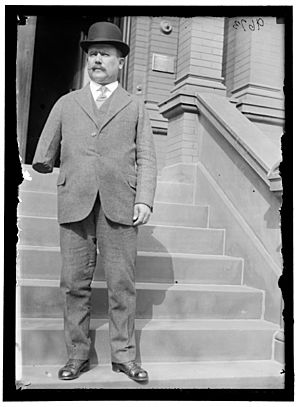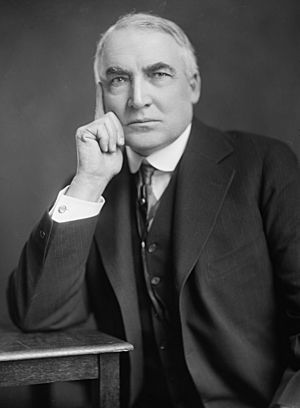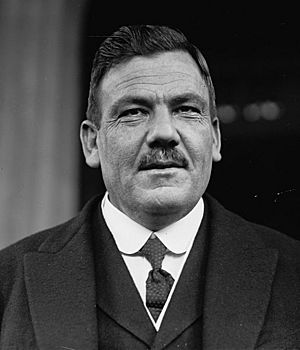Bucareli Treaty facts for kids
The Bucareli Treaty (Spanish: Tratado de Bucareli), officially called the Special Convention of Claims, was an agreement signed in 1923 between Mexico and the United States. It aimed to sort out problems and claims from US citizens and companies who had lost property or money during the Mexican Revolution.
The treaty also discussed how Mexico could take over US-owned land or oil resources for public use. It set rules for how much compensation (payment) would be given and how it would be paid. The meetings for the treaty happened in Mexico City at a building on Bucareli Street, which is how the treaty got its nickname. Negotiations started on May 15, 1923, and finished on August 13, 1923.
Mexican President Álvaro Obregón signed the treaty. His main goal was to get the US government, led by President Warren G. Harding, to officially recognize his government. However, the treaty's approval process was complicated in both countries. Later, Mexican President Plutarco Elías Calles agreed to follow the treaty for a short time, but then he canceled it.
Contents
Why the Treaty Was Needed

After the Mexican Revolution (1910-1921), Mexico was politically unstable. There were many military uprisings. One reason President Álvaro Obregón's government was weak was that the United States had not officially recognized it.
Mexico's 1917 Constitution had strong ideas about Mexico owning its own resources. This worried many US businesses. US President Warren G. Harding refused to recognize Obregón as the rightful leader. The US wanted Mexico to change parts of its Constitution, or at least make exceptions for US citizens.
For Obregón, getting US recognition was very important. It would help him avoid the constant threat of war. Just nine years earlier, the US had occupied Veracruz. Recognition also helped Obregón deal with problems inside Mexico, like the Delahuertista rebellion that happened in December 1923.
The Mexican Revolution had caused a lot of damage. Obregón believed that foreign direct investment (money from other countries) was needed to rebuild Mexico's economy. But the US said it would only recognize Obregón if Mexico promised to protect the property rights of US citizens and oil companies in Mexico.
The main issue was Article 27 of the Mexican Constitution. This article stated that Mexico directly controlled everything on its soil, including oil. This rule affected how US and European oil companies could own and extract oil.
The secret talks for the treaty happened from May to August 1923 in Mexico City.
The US government asked Mexico for a few things:
- Clarify Article 27 of the Constitution for foreign oil and farm properties.
- Restart payments on Mexico's external debt, which had been stopped.
- Pay money to foreigners for damages to their property during the revolution.
Mexico's Supreme Court decided that Article 27 would not apply to oil companies that were already there before 1917. They also said that if property was taken, fair payment must be made. Obregón tried to get money for debt payments by taxing oil. But oil companies stopped production, forcing the government to remove the tax.
What the Treaty Said
The Bucareli Treaty included different agreements. There were "General Conventions" (the public part) and "Special Conventions" (secret agreements).
The General Conventions were signed by Álvaro Obregón on August 13, 1923. They said:
- All damages to US investments because of the Mexican Revolution should be paid fairly.
The Special Conventions were agreed upon secretly, mostly through spoken promises. They were not written down in the signed treaty. In these secret talks, Obregón's representatives agreed to these terms with the US:
- US-owned farmland taken by Mexico would be paid for with special bonds. This applied to farms smaller than 1755 hectares.
- For larger properties, payment would be made immediately and in cash.
- A group would be created to review claims from 1868, but claims from the revolution would be handled separately.
- Article 27 would not apply to US citizens who had oil leases before 1917. This allowed them to keep extracting oil freely.
Because the Special Conventions were secret, they only represented President Obregón's personal wishes. This caused problems when the treaty was being approved in both countries. It also played a role in the Delahuertista rebellion.
How the Treaty Was Approved
The way the Bucareli Treaty was approved was different in Mexico and the United States.
In the US, the Senate asked for the secret "minutes" (the Special Conventions) that were not written in the treaty. The US Senate approved the General Conventions, and without realizing it, they also approved the secret Special Conventions. After being told the truth, the senators agreed to the Special Conventions. So, the entire Bucareli Treaty was technically approved in the US.
In Mexico, the situation was more difficult. President Obregón had to use strong measures to get the treaty approved in February 1924. One senator even said that the approval was "stained with the blood of one senator and the kidnapping of three others." Even with these extreme actions, the General Conventions barely got enough votes to pass. Some Mexican officials felt the agreement was too personal to Obregón and did not truly represent the Mexican government. The lack of open discussion made the treaty's approval less legitimate. The Special Conventions were even kept secret from Obregón's own cabinet members.
Overall, the way the treaty was approved in Mexico was not very democratic. This lack of open discussion and the harsh methods used hurt the treaty's standing and even Obregón's government. These problems became clear in December 1923 and affected later Mexican governments.
What Happened Next

The treaty said that claims had to be made within two years and processed within five years. However, the Bucareli Treaty did not have full legal power because it was not formally approved by the Congresses of both countries. It was more like a gentleman's agreement that only Obregón was bound to, not future presidents. Still, Obregón's government was recognized by the United States because of it. The exact amount of money paid to Americans under Obregón is not known.
Adolfo de la Huerta, who was a former interim president and Obregón's Secretary of the Treasury, said the treaty hurt Mexico's independence. He accused Obregón of betraying the nation. De la Huerta later resigned and started the Delahuertista rebellion in December 1923.
There is a common myth in Mexico that the treaty stopped Mexico from making advanced machines like engines or aircraft. People sometimes say this delayed Mexico's economic growth. However, the Mexican Revolution itself caused a lot of damage and stopped higher education and technology. It also scared away foreign direct investment.
The revolution did not actually destroy Mexico's factories or industries. Once the fighting ended in 1917, production started again. The full text of the Bucareli Treaty was published after it was signed, and it does not say anything about banning technology.
The Treaty Is Canceled

When Plutarco Elías Calles became President of Mexico on December 1, 1924, oil was still a major issue between Mexico and the US. Calles first met with US Ambassador Dwight Morrow and verbally agreed to follow the secret Special Conventions. But soon after, Calles rejected the Bucareli Treaty. He began to create a new oil law that would strictly follow Article 27 of the Mexican Constitution.
The US government reacted quickly. The US ambassador in Mexico, James Rockwell Sheffield, called Calles a "communist." The US Secretary of State, Frank B. Kellogg, even made a threat against Mexico on June 12, 1925.
US public opinion turned against Mexico when the first Soviet Union embassy in the world opened in Mexico. The Soviet ambassador even said that no two countries were more similar than the Soviet Union and Mexico. Some US government members then started calling Mexico "Soviet Mexico."
The debate over the new oil law happened in 1925, with US businesses against it. In 1926, the new law was passed. In January 1927, Calles's government canceled permits for oil companies that did not follow the new law. Mexico managed to avoid war through diplomacy. A direct telephone line was set up between Calles and US President Calvin Coolidge. Also, Ambassador Sheffield was replaced by Dwight Morrow, which helped improve relations.
Finally, on March 18, 1938, after many disagreements with foreign oil companies, Mexican President Lázaro Cárdenas ordered the Mexican oil expropriation. This created PEMEX, Mexico's national oil company.
Images for kids
-
Mexican President Álvaro Obregón (December 1, 1920 – November 30, 1924)
-
US President Warren G. Harding (March 4, 1921 – August 2, 1923)
-
Plutarco Elías Calles, President of México (December 1, 1924 - November 30, 1928)




